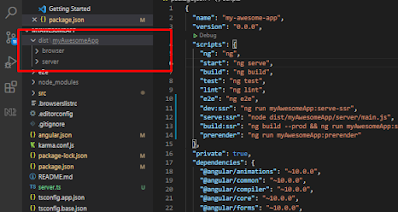Angular Universal is used to render an angular application at server side.Normally Angular is a framework that is used to build Single Page Applications (SPA's) and executes on the browser which means angular application renders on client side , not on the server side.
Angular is not SEO friendly by default and You need your angular app to be working in Google search engines so that is the issue with angular and here I am here to solve this issue, for that we need to switch our angular application as Universal App so that we can implement server side rendering in our angular application.
Here we have a brand new angular project that i just created by using this command
ng new myAwesomeApp<!doctype html>
<html lang="en">
<head>
<meta charset="utf-8">
<title>MyAwesomeApp</title>
<base href="/">
<meta name="viewport" content="width=device-width, initial-scale=1">
<link rel="icon" type="image/x-icon" href="favicon.ico">
</head>
<body>
<app-root></app-root>
<script src="runtime.js" defer></script><script src="polyfills.js" defer></script><script src="styles.js" defer></script><script src="vendor.js" defer></script><script src="main.js" defer></script></body>
</html>ng add @nguniversal/express-enginesrc/
index.html app web page
main.ts bootstrapper for client app
main.server.ts * bootstrapper for server app
style.css styles for the app
app/ ... application code
app.server.module.ts * server-side application module
server.ts * express web server
tsconfig.json TypeScript base configuration
tsconfig.app.json TypeScript browser application configuration
tsconfig.server.json TypeScript server application configuration
tsconfig.spec.json TypeScript tests configurationHow to start the angular universal ?
npm run build:ssrnpm run serve:ssr
<!DOCTYPE html><html lang="en"><head>
<meta charset="utf-8">
<title>MyAwesomeApp </title>
<base href="/">
<meta name="viewport" content="width=device-width, initial-scale=1">
<link rel="icon" type="image/x-icon" href="favicon.ico">
<link rel="stylesheet" href="styles.3ff695c00d717f2d2a11.css"><style ng-transition="serverApp"></style><style ng-transition="serverApp">.toolbar[_ngcontent-sc16] {
position: absolute;
top: 0;
left: 0;
right: 0;
height: 60px;
display: flex;
align-items: center;
background-color: #1976d2;
color: white;
font-weight: 600;
}
@media screen and (max-width: 575px) {
svg#rocket-smoke[_ngcontent-sc16] {
display: none;
visibility: hidden;
}
}</style></head>
<body>
<app-root _nghost-sc16="" ng-version="10.0.14"><div _ngcontent-sc16="" role="banner" class="toolbar"><img _ngcontent-sc16="" width="40" alt="Angular Logo" src="data:image/svg+xml;base64,PHN2ZyB4bWxucz0iaHR0cDovL3d3dy53My5vcmcvMjAwMC9zdmciIHZpZXdCb3g9IjAgMCAyNTAgMjUwIj4KICAgIDxwYXRoIGZpbGw9IiNERDAwMzEiIGQ9Ik0xMjUgMzBMMzEuOSA2My4ybDE0LjIgMTIzLjFMMTI1IDIzMGw3OC45LTQzLjcgMTQuMi0xMjMuMXoiIC8+CiAgICA8cGF0aCBmaWxsPSIjQzMwMDJGIiBkPSJNMTI1IDMwdjIyLjItLjFWMjMwbDc4LjktNDMuNyAxNC4yLTEyMy4xTDEyNSAzMHoiIC8+CiAgICA8cGF0aCAgZmlsbD0iI0ZGRkZGRiIgZD0iTTEyNSA1Mi4xTDY2LjggMTgyLjZoMjEuN2wxMS43LTI5LjJoNDkuNGwxMS43IDI5LjJIMTgzTDEyNSA1Mi4xem0xNyA4My4zaC0zNGwxNy00MC45IDE3IDQwLjl6IiAvPgogIDwvc3ZnPg=="><span _ngcontent-sc16="">Welcome</span>$lt;div _ngcontent-sc16="" class="spacer"></div>$lt;a _ngcontent-sc16="" aria-label="Angular on twitter" target="_blank" rel="noopener" href="https://twitter.com/angular" title="Twitter"><svg _ngcontent-sc16="" id="twitter-logo" height="24" data-name="Logo" xmlns="http://www.w3.org/2000/svg" viewBox="0 0 400 400"><rect _ngcontent-sc16="" width="400" height="400" fill="none"></rect><path _ngcontent-sc16="" d="M153.62,301.59c94.34,0,145.94-78.16,145.94-145.94,0-2.22,0-4.43-.15-6.63A104.36,104.36,0,0,0,325,122.47a102.38,102.38,0,0,1-29.46,8.07,51.47,51.47,0,0,0,22.55-28.37,102.79,102.79,0,0,1-32.57,12.45,51.34,51.34,0,0,0-87.41,46.78A145.62,145.62,0,0,1,92.4,107.81a51.33,51.33,0,0,0,15.88,68.47A50.91,50.91,0,0,1,85,169.86c0,.21,0,.43,0,.65a51.31,51.31,0,0,0,41.15,50.28,51.21,51.21,0,0,1-23.16.88,51.35,51.35,0,0,0,47.92,35.62,102.92,102.92,0,0,1-63.7,22A104.41,104.41,0,0,1,75,278.55a145.21,145.21,0,0,0,78.62,23" fill="#fff"></path></svg></a></div><footer _ngcontent-sc16=""> Love Angular? <a _ngcontent-sc16="" href="https://github.com/angular/angular" target="_blank" rel="noopener"> Give our repo a star. <div _ngcontent-sc16="" class="github-star-badge"><svg _ngcontent-sc16="" xmlns="http://www.w3.org/2000/svg" width="24" height="24" viewBox="0 0 24 24" class="material-icons">$lt;path _ngcontent-sc16="" d="M0 0h24v24H0z" fill="none"></path><path _ngcontent-sc16="" d="M12 17.27L18.18 21l-1.64-7.03L22 9.24l-7.19-.61L12 2 9.19 8.63 2 9.24l5.46 4.73L5.82 21z"></path></svg> Star </div></a><a _ngcontent-sc16="" href="https://github.com/angular/angular" target="_blank" rel="noopener">$lt;svg _ngcontent-sc16="" xmlns="http://www.w3.org/2000/svg" width="24" height="24" viewBox="0 0 24 24" class="material-icons">$lt;path _ngcontent-sc16="" d="M10 6L8.59 7.41 13.17 12l-4.58 4.59L10 18l6-6z" fill="#1976d2"></path><path _ngcontent-sc16="" d="M0 0h24v24H0z" fill="none"></path></svg></a></footer>$lt;router-outlet _ngcontent-sc16=""></router-outlet></app-root>
<script src="runtime.e227d1a0e31cbccbf8ec.js" defer="">$lt;/script>$lt;script src="polyfills.a4021de53358bb0fec14.js" defer=""></script><script src="main.81da75e4d35b2c841f7b.js" defer=""></script>
</body>$lt;/html>Summary:
npm run build:ssr
npm run serve:ssrnpm run dev:ssr
npm run serve:ssr




.jpg)




0 Comments